In today’s digital world, where businesses are venturing out into all areas of trust-building, why should generating reviews be left behind?
A report from 2021 tells us that 99.9% of consumers read reviews when shopping online. This number is insane and is more or less the same across all product categories. So whether consumers are out there buying books or simply dining out, they tend to rely heavily on reviews.
Yet, creating a review generation strategy that can help bring authentic reviews can pose a challenge for most businesses.
They often struggle with customer reluctance, time constraints, and managing negative or fabricated reviews. But, fortunately review generation tools offer businesses a ray of hope. By using the right tools and strategies businesses can turn this challenge into an opportunity for growth.
In the below sections, we will discuss the importance of reviews and dive into strategies that can help businesses generate reviews that are organic, authentic and positive.
Why Are Reviews Important for Your Business?
75% of customers claim to “always” or “regularly” read online reviews when researching businesses. At the same time, only 3% of consumers claim to never read reviews. This tells us the growing importance of online reviews in today’s day and age.
Here is what makes reviews so important for businesses:
1. Influence on Purchase Decisions
Feedback on review sites is the digital equivalent of personal recommendations in today’s day and age. While positive feedback creates a sense of assurance and reliability, negative reviews can deter even the most interested buyers.
A study found that customers are willing to spend 31% more on products or services with positive reviews. On the flip side, a negative review can drive away up to 40% of potential buyers.
This data clearly reflects that customer reviews directly affect the purchase decisions of potential customers.
2. Impact on SEO and Online Visibility
Search engines reward businesses with a consistent stream of reviews.
Recent data indicates that review signals contribute to approximately 15% of local SEO ranking factors. Review sites like GMB play a pivotal role here. Businesses with frequent positive reviews are often listed higher in search results, which directly leads to increased discoverability.
3. Establishing Brand Credibility and Trust
Products that have just five or more reviews are 270% more likely to be purchased.
This tells us that customer reviews are powerful social proofs. They help validate the quality and reliability of a business. Potential customers often gravitate toward businesses with authentic feedback detailing real experiences.
4. The Psychological Edge
Customer reviews often trigger the emotional and psychological responses of the readers.
While positive reviews make potential buyers feel more optimistic, negative feedback can create suspicion in their minds. However, responding to negative reviews effectively demonstrates a business’s commitment to improvement, further building trust.
5. Reviews’ Role in Customer Retention
Businesses don’t just need new customers; they must also retain the old ones.
93% of customers expect businesses to respond to their online reviews. Regularly engaging with customer feedback and replying to reviews shows that a business values its customers’ opinions.
This responsiveness fosters loyalty and helps businesses create stronger bonds with their customers. Businesses can also humanize their brand, build communities, and bring better engagements by valuing customer feedback.
Let us now talk about some strategies that can help businesses effectively revamp their online review generation processes:
Effective Strategies for Review Generation
As we know, building trust and attracting new clients often hinges on customer reviews. Using efficient strategies to generate reviews can help businesses establish a robust reputation and enhance their visibility.
Below are some proven review generation strategies for generating authentic and impactful customer feedback:
- Automate the Process of Review Generation
- Ethically Incentivize Customers for Reviews
- Make the Review Process Simpler
- Ask for Reviews at the Right Time
- Showcase Existing Reviews
- Respond to all Reviews
- Engage on Social Media
- Build a Presence on Major Review Sites
1. Automate the Process of Review Generation
Let’s face it—generating reviews manually is not only difficult but can eventually become impossible as the operations expand.
But what if there was a way that could help businesses make review generation easier and consistent? Enter automation. Automating the review generation process not only saves time but it can help businesses maintain a consistent flow of authentic reviews, without any hassle.
Instead of manually reaching out to every customer and asking them to share feedback, you can set up automated email or SMS requests that trigger after specific actions. Businesses can send these review requests soon after a product delivery or on completion of a service appointment.
This can help them get more organic reviews without even lifting a finger once the automation setup is in place! For example, Best Western Hotels & Resorts implemented an automated review request system to prompt guests to leave feedback on Google and TripAdvisor. This led to a 27% increase in their review volume.
Here are some benefits of automating review requests:
- More Reviews in Less Time: Automating the review request process reduces manual effort and brings in timely and consistent feedback.
- Enhances Customer Engagement: Automated systems ensure no customer interaction is missed, helping businesses maintain a steady flow of reviews.
- Boosts Brand Reputation: By collecting and managing more reviews, businesses can strengthen their online presence and build trust among potential customers.
- Personalization: Businesses can set up automated email and SMS campaigns that align with their specific customer journeys to foster a more personal bond with their customers.
Want to know how to get started on this automation journey?
Use SocialPilot Reviews to set up automated review campaigns that can help you trigger a review request via email or SMS at just the right moment—whether it’s after a purchase, a service appointment, or a customer interaction.
Once automated, you’ll never miss an opportunity to ask for a review.
Not only will this tool save you time, but it will also ensure that all your review messages are personalized and match your brand’s tone. So, try this tool to automate your review requests, so you can focus on what matters most—running your business.
Start Your 14-day Trial
2. Ethically Incentivize Customers for Reviews
While incentivizing customers can be a great way to encourage them to share their thoughts, it’s important to do it right.
First off, don’t offer discounts, free gifts, or anything of value in exchange for reviews.
All review platforms, like Google, Yelp, TripAdvisor, etc, strictly prohibit any form of compensation for reviews, and violating these guidelines could result in penalties, including your reviews being removed or your business being flagged.
The real goal of asking for reviews isn’t just to rack up five-star ratings that improve your SEO but to help prospective customers make informed decisions about your products or services.
Authentic, honest reviews from real customers build trust with future buyers.
So, while offering rewards for positive feedback might seem tempting, it’s important to keep things transparent and genuine.
Here are some ways in which businesses can ethically offer incentives for feedback:
- Loyalty Points: Points awarded to customers that they can later exchange for discounts on their stores or websites.
- Exclusive Offers: Advance access to new products or services.
- Entry into Giveaways: Customers can enter raffles for a chance to win some rewards by leaving reviews.
The image below demonstrates how businesses can ethically incentivize customers and motivate them to leave reviews. In this, the business offers a unique code to help customers get $15 off on their next order.
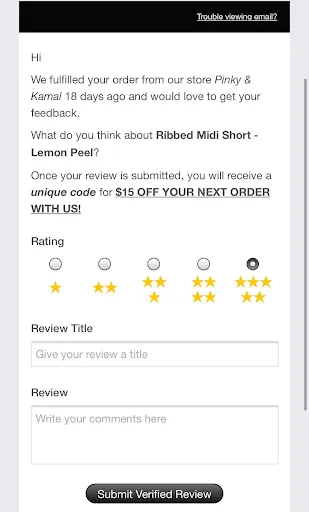

By sticking to these ethical review practices, your business will not just comply with the platform guidelines, but it will build a stronger and more trustworthy reputation in the market.
3. Make the Review Process Simpler
When it comes to collecting reviews, the simpler, the better.
If customers face any challenges—like long forms, confusing steps, or excessive details—they’re more likely to abandon the process. The key is to streamline the review experience, making it effortless for them to leave their thoughts.
Streamlining the online review generation process reduces obstacles and enables customers to provide more reviews. The goal is to remove friction. The more straightforward you make it, the more likely customers will take the time to share their feedback.
Offering a one-click review option or minimizing the number of fields they need to fill out the review can increase participation significantly.
Here is how businesses can simplify the review generation process:
- QR Codes: Add QR codes to receipts, packaging, or business cards that direct customers to review pages with a single scan. As shown in the image below, businesses can also put these simple QR codes at their physical locations. Any customer who scans it will be redirected to your GMB profile, where they can leave a review.


- Direct Links: Send emails and SMS review requests with direct, clickable links to make it easy for customers to leave reviews. The image below shows how businesses can send emails and SMS to their customers with direct review links and increase their chances of receiving a review.
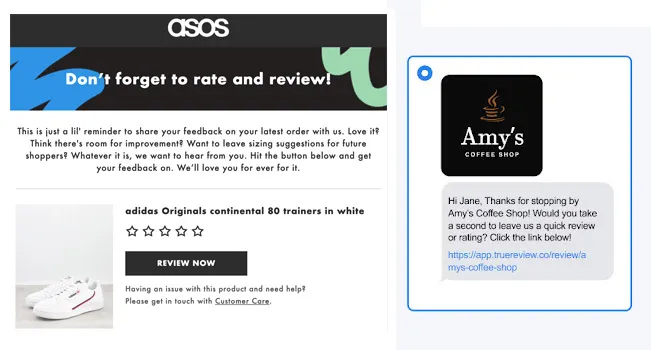

- Embedded Forms: Embed review forms straight onto your website or mobile application to enable in-app feedback collection. For example, suppose you own an online store selling shoes, you can embed a review form on the order confirmation page. This will allow your customers to share their feedback immediately after their purchase.
Showcasing these real-time reviews is gold because it shows new visitors that real folks love your products.
Additionally, you can also include QR codes in order confirmation emails, making it easy for customers to scan and leave a review once they receive their shoes.
4. Ask for Reviews at the Right Time
Timing is everything, especially when it comes to asking for reviews.
It can significantly influence both the quality and quantity of reviews. If you ask for reviews at the perfect time—right after a positive experience—you increase both the quantity and quality of feedback you receive.
Conversely, if you reach out at the wrong moment, the chances of getting a response can drop significantly.
The ideal time to request a review is immediately after the customer has had a pleasant experience or when they come to you with praise. They’ll be more inclined to leave a thoughtful, glowing review if they’re genuinely satisfied with your business and in a good mood.
Here are some timing tips to keep in mind:
- After Delivery: If your product can be assessed immediately, request reviews immediately after it is delivered to capture first impressions.
- Service Completion: Follow up with a request once the service is successfully provided.
- Problem Resolution: Customers often feel grateful soon after their problems are resolved, making it a perfect time to request feedback.
5. Showcase Existing Reviews
Don’t just ask for reviews—flaunt them.
Displaying existing reviews on websites, social media, and marketing materials builds trust and also inspires others to share their experiences. Sharing positive feedback helps businesses leverage the power of social proof—wherein people trust the opinions of others, especially when they’re uncertain.
Consumers are more likely to trust the experiences and feedback of other customers than the business’s own marketing claims. So, when businesses showcase their existing reviews, they’re essentially letting their satisfied customers vouch for them.
Here are some ways in which businesses can share real customer stories to establish customer trust:
- Highlight Positive Testimonials: Feature detailed, relatable customer stories that resonate with potential buyers.
- Incorporate Visuals: Use video testimonials or photos to create emotional connections.
- Social Media Sharing: Regularly post reviews on social platforms, thanking customers for their feedback. For example, an e-commerce site can showcase customer reviews with images of customers using the products, boosting authenticity and engagement.
6. Respond to Reviews:
Did you know that responding to reviews within 24 hours can increase customer satisfaction by 33%?
Interacting with customer feedback, regardless of whether it is favorable or unfavorable, shows care and professionalism. It also makes customers engage with your brand.
When customers feel heard and valued, they develop loyalty towards a brand. A simple “thank you” response to positive reviews can go a long way in reinforcing customer satisfaction and deepening their connection with your brand.
On the flip side, responding to negative feedback shows a business’s professionalism and commitment to solving problems.
Here are some response tips for businesses:
- Positive Reviews: Responding to positive reviews is like giving a high-five back! A simple, “Thanks so much for your kind words, [Name]! We’re thrilled you loved our product/service. Hope to see you again soon!” shows appreciation and acknowledges the customer’s specific experience.
Try adding a layer of personalized touch to make your business feel more approachable and trustworthy.
- Negative Reviews: Respond to negative reviews with grace and attentiveness. Start with a genuine apology, like, “We’re really sorry to hear you had a less than stellar experience, [Name].” Acknowledge their specific issues, which shows you’re paying attention, and offer to make things right.
Then, take the conversation offline if it’s something detailed, suggesting, “Could you please email us at [contact info] so we can make this right?” This strategy helps de-escalate the situation and demonstrates your commitment to resolving issues.
Struggling to keep up with all your customer reviews?
SocialPilot Reviews make it easier for businesses to respond to all feedback in a prompt and professional manner. The tool comes with a centralized dashboard that helps businesses keep track of all their reviews on different review platforms.
Additionally, its AI-powered review response feature can craft responses in a flash.
So, whenever a new review comes in, just click the “Reply with AI” button, and the system will generate a thoughtful, personalized response, as shown in the image below. This review response is completely customized based on the content of the review.
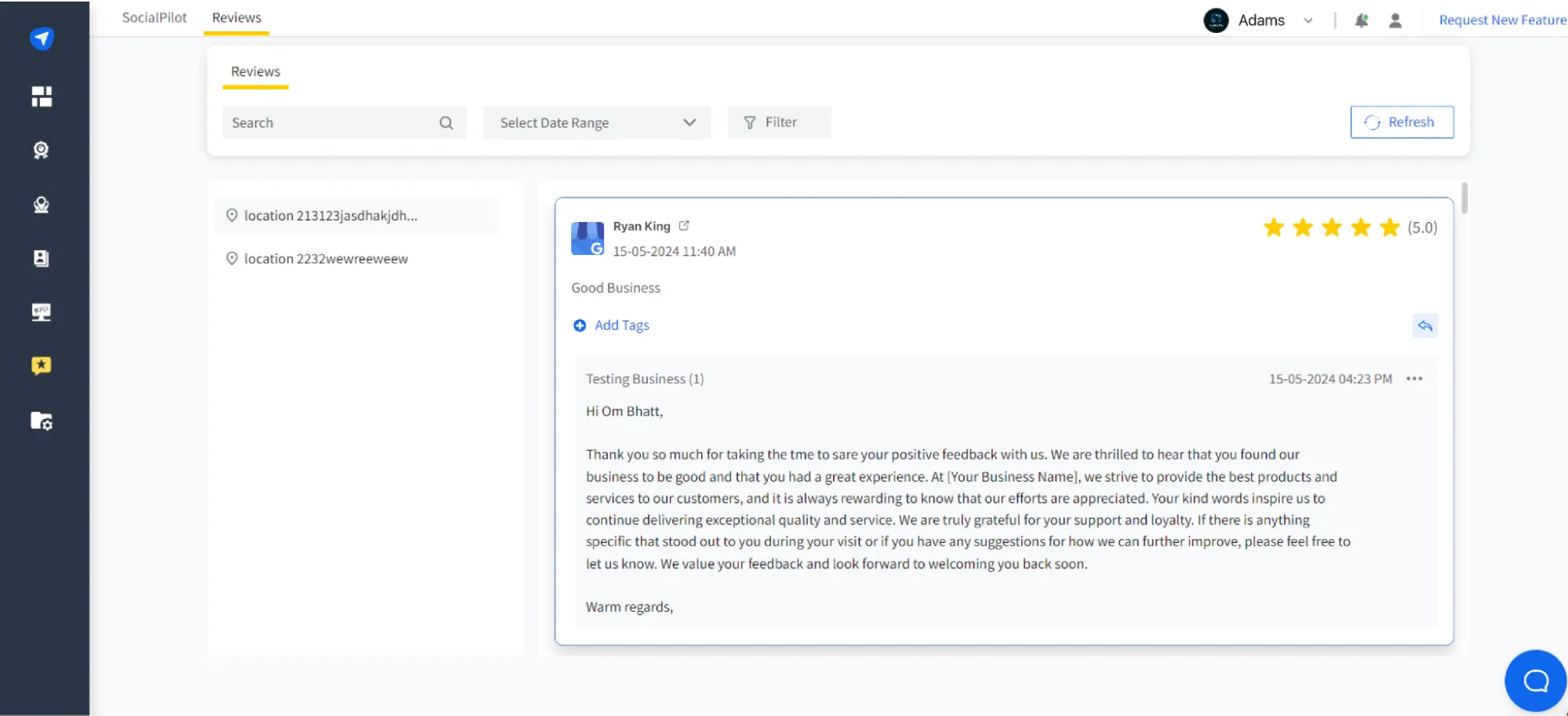

Start Your 14-day Trial
Social media isn’t just for posting pictures or announcements—it’s also a powerful platform to build relationships and gather customer feedback.
Engaging with your audience on social media helps you humanize your brand and make customers feel seen and heard, ultimately leading to more reviews and stronger brand loyalty.
When you actively engage on social media, you create a space where customers feel comfortable sharing their experiences and opinions. It also presents an opportunity for businesses to invite feedback in a casual and organic way.
For instance, brands can post about their products or services and include a call-to-action, asking their followers to leave a review if they’ve had a great experience. They can also share a few customer testimonials and tag people who left them a review. This not only shows appreciation but also encourages others to follow suit.
8. Building a Presence on Major Review Sites
61% of consumers check business reviews on 2-3 sites before making a decision.
Customers often compare reviews across different sites to get a complete picture of your business, which means you need to be visible and active on several key review platforms.
As a business, you must use a review generation platform that integrates with multiple review-hosting sites to streamline this process. This will help you maintain a multi-dimensional presence and also increase your chances of being found by consumers.
Besides the much-needed exposure, this can also help them establish their credibility.
Here are some popular review sites:
- Google Business Profile
- Apple Maps Listings
- Yelp
- TripAdvisor (best for restaurants, hotels, and resorts)
By following these above-mentioned hacks, businesses can ensure a steady flow of authentic customer reviews, which can help them boost their online reputation and credibility.
How to Generate Reviews Across Platforms
Businesses must collect customer data across diverse platforms to maximize their reach and impact. However, all these review platforms cater to different audiences and require customized approaches.
Let’s now explore strategies for generating reviews across major platforms like Google, Facebook, Yelp, etc.
Google: The Gateway to Local Search
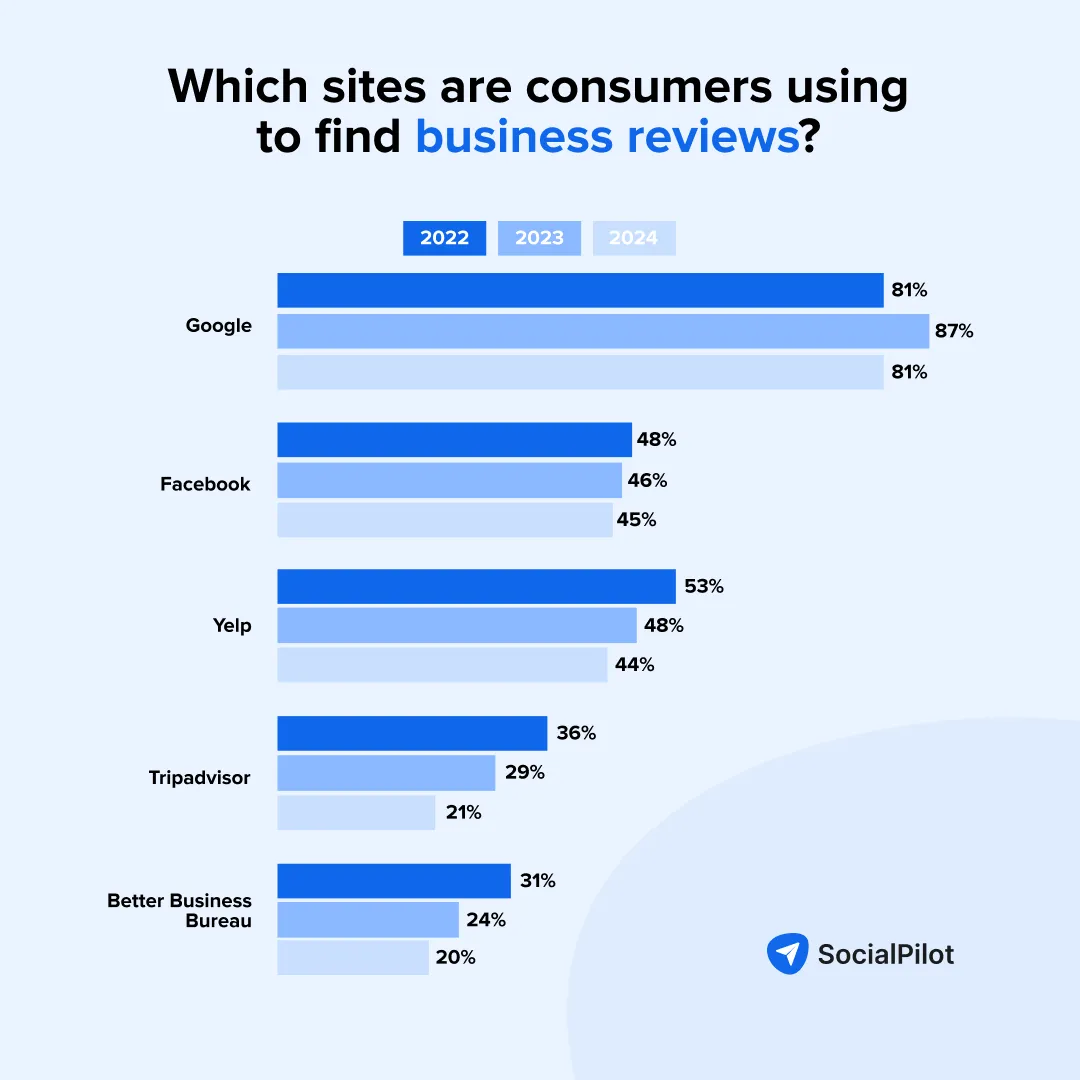

81% of consumers check Google when looking for online reviews of local businesses.
The reviews on Google not only help companies improve their local SEO but also build customer trust. Reviews generated on this platform directly influence a business’s ranking on Google’s search and map results, making it critical to capture customer sentiment here.
- Claim and Optimize Your Google Business Profile: Regularly update operating hours, service descriptions, and photos. A complete profile makes it easier for customers to find your business and leave reviews.
- Use Direct Links to Google Reviews: Include a “Leave a Review” link in follow-up emails or SMS review requests. Make it easily accessible so that a single click can take your users to Google’s review submission page.
- Create a QR code for Google Reviews: Generate a QR code to simplify the process of online review generation. Adding this QR code to business cards, thank-you notes, postcards, or websites can help businesses get more customer reviews.
- Use a Review Template: Businesses can create a smart Google review template by providing clear, easy-to-follow instructions and personalizing the message to make it feel genuine. They can then easily integrate them into emails, social posts, or thank-you notes to effectively collect reviews.
Note: Google’s policies explicitly discourage businesses from soliciting only positive online reviews. Businesses must ensure that all requests are balanced and inclusive.
Customers most commonly use Facebook and Instagram to read reviews on social media.
Not just that, Facebook reviews make up 19% of all customer reviews online, making this platform inevitable for businesses seeking to build trust and credibility.
- Set Up a Reviews Tab on Your Facebook Business Page: Ensure your FB business page has the Reviews tab activated to make it easy for customers to leave their feedback.
- Engage Customers Through Direct Communication: Initiate conversations with your customers via chat or email, expressing your appreciation and requesting them to share their experiences. Regular reminders, such as “Have we made your experience worthwhile? Let us know,” spark an engagement.
For instance, the image below shows how Wanderu has sent a personalized email to one of their customers, Anna, seeking her review.
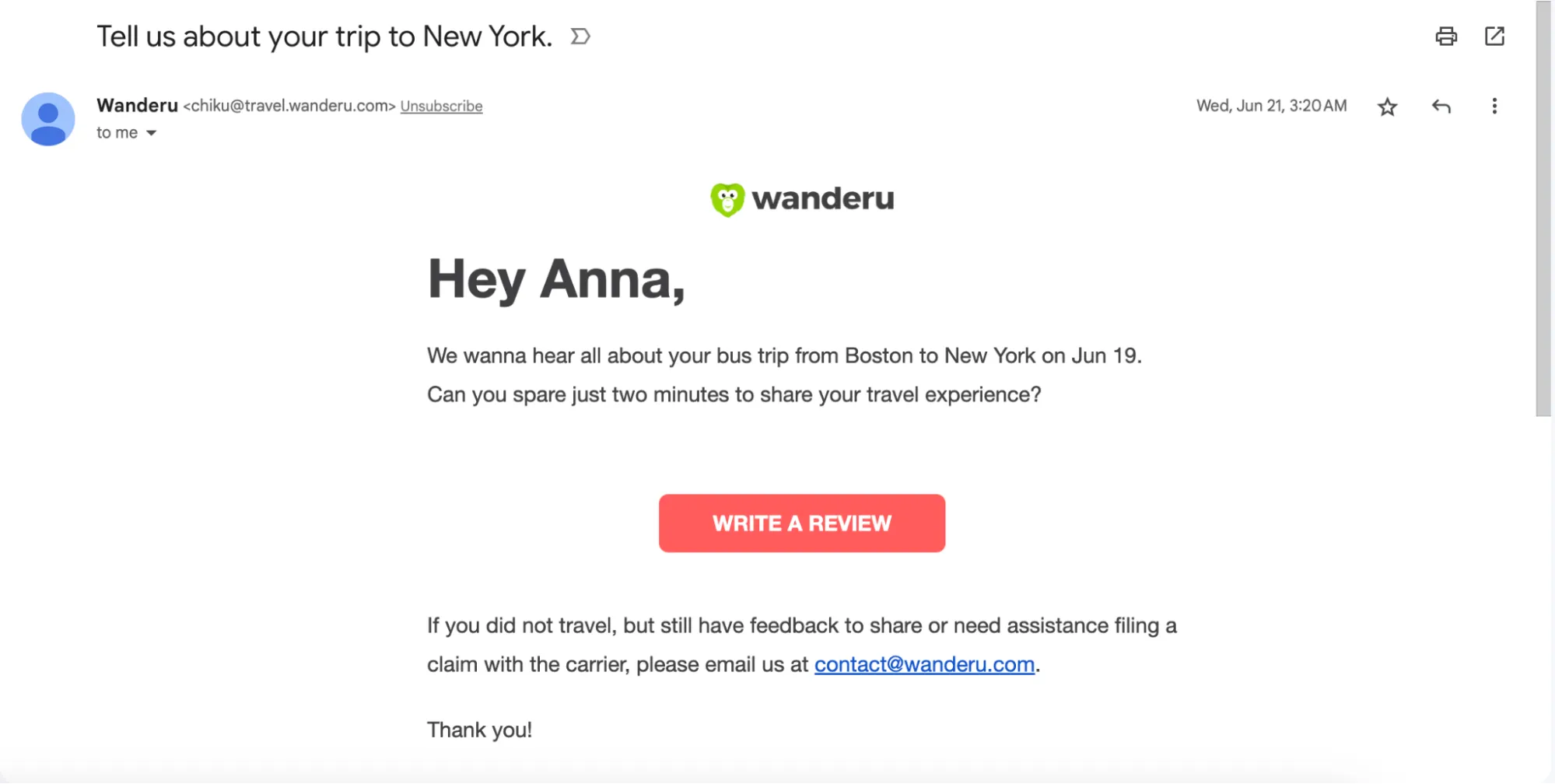

- Encourage Facebook Check-ins at Your Physical Location: Motivate customers to check in on Facebook when they visit your physical location. This action increases the visibility of your business on social media and prompts Facebook to remind them to leave a review.
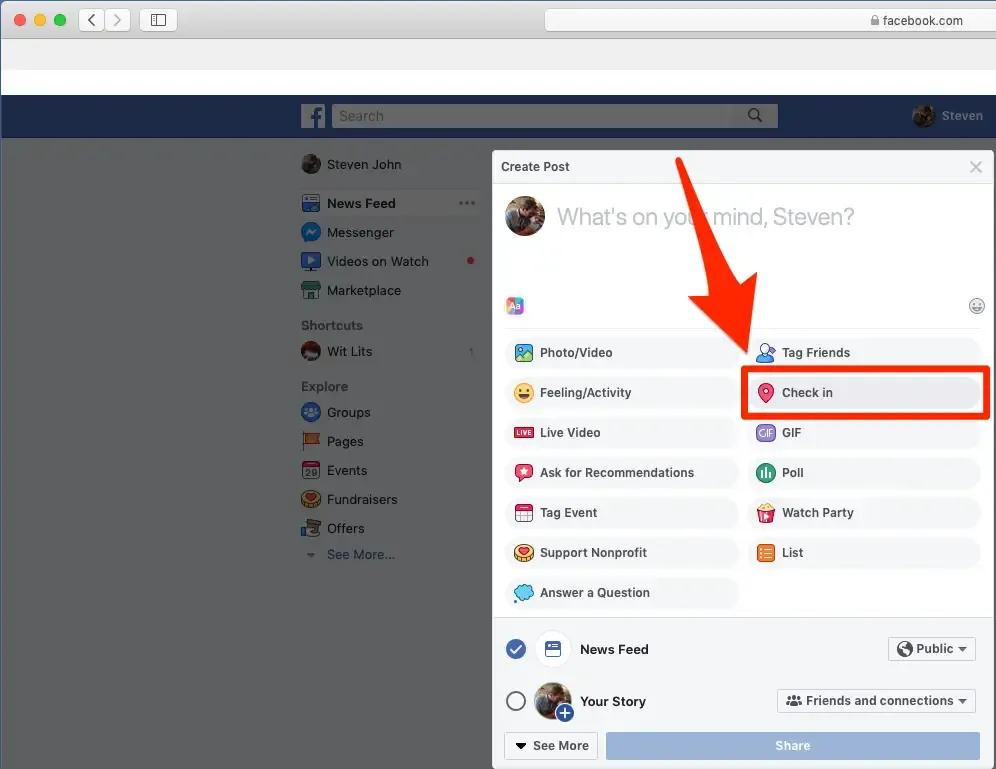

- Prompt Reviews Through Social Media Posts: Regularly post on your FB business page and encourage your followers to talk about their experiences and leave reviews. Engaging posts can motivate your audience to contribute and share their feedback.
- Use Ads to Target Existing Customers: When running ads, add CTAs like “We’d love your feedback!” or “Share your experience with us!” in ads, asking for feedback from individuals who’ve interacted with your business.
Note: Facebook reviews emphasize engagement over sheer numbers. Regularly engaging with customers enhances trust.
Yelp: The Go-To for Lifestyle and Dining
Founded in 2004, Yelp is among the best online reputation management platforms, with almost 178 million unique visitors coming to this platform every month. Yelp users are selective but highly influential. This platform is great for local businesses, and its reviews can significantly drive foot traffic for businesses.
- Claim and manage your business listing on Yelp: This will help people find your business. Update all essential details like hours, addresses, and phone numbers, and upload photos to highlight the best aspects of your business.
- Encourage Reviews Post-Purchase: Do not explicitly ask for reviews, as Yelp advises business owners not to solicit reviews. Instead, use tools like badges, links, and a Yelp sticker to guide people to explore your business on Yelp. Businesses can also use printed cards, in-store signage, or QR codes to encourage Yelp reviews.
- Engage With Your Community: Yelp provides free tools to help you convert visitors into customers. Use these features to prompt potential customers to request quotes, book appointments, or ask questions directly from your Yelp page.
- Engage with These Feedbacks Publicly: Take the time to respond thoughtfully to reviews on Yelp, be it positive or negative; this transparency reassures potential customers and builds your review performance.
- Leverage Yelp Ads: Running sponsored profiles boosts visibility, draws attention to your business, and encourages new visitors to review.
Note: Yelp users value authenticity. Avoid overwhelming requests, as they may flag inorganic reviews.
Niche Platforms for Targeted Audiences
Targeted platforms cater to specific industries and customer needs, such as TripAdvisor for travel or Zocdoc for medical services. Reviews here are highly credible because they speak directly to their relevant audience.
- TripAdvisor: Travelers often depend on TripAdvisor for detailed travel reviews. Follow up with tourists after their trip or stay connected with them via emails or messages that help them rekindle their travel memories and leave reviews.
- Zocdoc and Healthgrades: Personalized email requests work well with patients. Ensure the tone is professional yet warm, inviting constructive feedback.
- Angi or Avvo: Service-based industries (e.g., contractors or attorneys) benefit from reviews detailing their expertise. Prompt clients immediately after the completion of a project or case closure.
Note: Some niche platforms have stringent review performance and verification processes, making it crucial to encourage detailed, genuine submissions.
While generating reviews can be a game-changer for businesses, it’s not always as easy as it sounds. Let us now discuss some challenges that businesses might face when generating reviews.
Challenges in Review Generation
From customer reluctance to managing negative reviews or navigating the overwhelming number of platforms, here are some common challenges:
1. Encouraging Customer Participation
Satisfied customers often assume their experience speaks for itself and may not leave reviews. In contrast, dissatisfied customers are significantly more likely to post a negative online review, decreasing the overall review rating.
Businesses can use review generation software like SocialPilot Reviews to nudge satisfied customers into action using personalized email and text review request campaigns with clear calls to action and seamless review submission processes.
2. Time-Intensive Processes
Manual review requests can get you more reviews but can be labor-intensive, particularly for small businesses. Crafting personalized follow-ups, sending review links, and monitoring submissions can take up a lot of time and effort.
Automating and streamlining this process can make it viable on a larger scale. This can help businesses gather more reviews by putting in less effort while also improving their online reputation.
3. Addressing Negative Feedback
Negative reviews require immediate yet thoughtful responses to mitigate potential fallout. Mishandling complaints or arguing can escalate dissatisfaction and damage the reputation of a business, whereas a measured approach to handling reviews demonstrates accountability and care.
Businesses must craft timely and effective responses to manage negative feedback.
4. Managing Fake Reviews
Fake reviews are on the rise, and it is a matter of concern. 75% of customers are concerned about fake reviews on websites.
Whether these are malicious posts from competitors or exaggerated claims by dishonest customers, these falsified reviews can break a business. Businesses must respond publicly to suspected fake reviews with factual corrections, however politely. Moreover, these reviews can be flagged and removed if they violate the platform’s review policies.
5. Platform Dependency
Relying solely on a single review platform, such as Google, Yelp, or TripAdvisor, can be limiting. Diversification is crucial to reach your customers across all touchpoints. However, managing these multiple platforms can be challenging.
This is where review management tools can greatly help. Tools such as SocialPilot Reviews come with a centralized dashboard to make review management prompt and easy.
Here are some reasons why businesses need review management platforms:
- To proactively request reviews through automated campaigns via email or SMS, encouraging feedback across diverse platforms.
- Never miss any new review, as these tools give you instant alerts whenever a customer leaves you a review.
- Display all reviews from multiple sources in one centralized dashboard for easier management.
- Set up automatic responses for common review scenarios, ensuring timely interaction.
- Their analytics features can help you identify trends and areas for improvement across various platforms, helping you make informed decisions.
6. Balancing Review Quantity and Quality
Striving for more customer reviews is essential, but the quality of reviews is equally important. Overwhelmingly generic or irrelevant feedback offers little to no value and, hence, is of no use.
Achieving the right balance requires collecting detailed, meaningful feedback without overwhelming clients with extensive forms or surveys. For instance, asking, “What did you like most about the product?” encourages constructive detail.
7. Engaging the Right Audience
Targeting the ideal customers for reviews can also pose a challenge. Some customers might lack the technical know-how to navigate review platforms, while others may prefer to communicate their feedback directly without leaving a public review.
Businesses must implement inclusive strategies that cater to diverse customer preferences.
Lastly, here are some do’s and don’ts of review generation strategy to keep businesses on track when collecting feedback:
Do’s and Don’ts of Review Generation
A successful online review generation strategy is one built on ethical practices and consistent efforts.
While reviews are instrumental in shaping business credibility, mishandling the process can lead to mistrust and negative outcomes. Below are some do’s and don’ts every business must follow to ensure effective and ethical review management.
Do’s
- Create and Claim Your Business Profile: Businesses must be active on platforms like Yelp, Facebook, Google, and others related to their niche. They must regularly access features like page stats, boost their search visibility, and regularly update and verify their listings to ensure accurate information.
- Respond Promptly and Graciously:89% of people read the business’s responses to reviews. Whether the review is glowing or critical, acknowledging and replying to them fosters trust.
- Have a Process in Place: Businesses must have an automation process in place to help them track mentions and notifications, schedule responses, and manage engagement.
- Make it Simple to Leave Reviews: Data suggests that 86% of people would actually consider leaving reviews for your business. So, make the process simpler, have a clear call to action in emails, on your website, or at your front desk, and provide direct links to review sites.
- Focus on Authenticity: Request reviews from a diverse customer base for a mix of best reviews and constructive feedback. This will reassure your future customers that the reviews are real and reliable.
Don’ts
- Never Miss Opportunities to Engage: Engage with negative reviews by responding thoughtfully and using feedback to improve your business.
- Avoid Excessive Follow-Ups: A barrage of reminders can irritate customers and tarnish your brand reputation. Limit follow-ups to a few polite nudges, spaced out appropriately.
- Never Ignore Negative Feedback: Maintaining silence towards critical reviews signals your indifference. Always address complaints constructively, even if they appear unfair or unjustified.
- Steer Clear of Fake Reviews: Avoid generating fake reviews, as they damage your credibility, and there is always a risk of removal from major review platforms. Also, consumers today can easily spot false reviews, which are often from newly created fake profiles or bots.
- Don’t Neglect Small Platforms: Platforms like niche directories or industry-specific review sites matter just as much as giants like Google and Facebook. Businesses must broaden their efforts to capture a larger and more targeted audience.
Conclusion
We’re living in times where online reviews are pretty much the heartbeat of a business’s reputation.
People develop their opinions based on what they read about your business online. A Harvard Business School study proved that just a one-star rating improvement can boost the sales of a business by 5-9%. That’s huge! It really shows just how powerful reviews can be.
While managing reviews well can be a game-changer for businesses, leaving them to chance can be the cause of many failed opportunities. But managing reviews is more than just collecting them. It also involves sending timely review requests, responding promptly, and using the feedback to improve your products or services.
SocialPilot Reviews is among the best review management platforms, making generating and managing reviews easy and hassle-free.
Make online reviews the driving force for your business’s success. Use SocialPilot Reviews today and watch your business reputation reach new heights.
